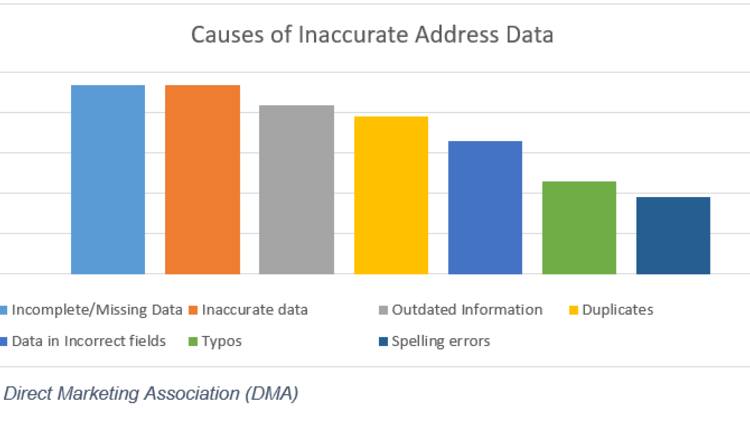This article originally appeared in the March/April issue of Mailing Systems Technology.
Last September, we published an article with an in-depth look at Undeliverable-as-Addressed (UAA) mail, where it comes from, and how to fix it. After the article had been published, we received an interesting follow-up question: What factors impact address quality?
There are two answers to this question: factors in the collection of address data at the front end, and factors that affect the addresses at the time of your mailing (at the back end). We’ll take a brief look at both.
Collection of Addresses that Impact Quality
Each year, the Direct Marketing Association (DMA) collects, compiles, and publishes its Statistical Fact Book. It’s a definitive source of benchmarks for data-driven marketing.
The report indicates that nearly 75% of businesses believe inaccurate data prevents them from finding new customers, increasing sales, and providing good customer service. It also leads to a poor decision-making process and costs millions in wasted marketing expenses. On average, US organizations believe 25% to 33% percent of their data is inaccurate.

Some data entry may not always be a mistake. How often do people give incomplete or inaccurate information to safeguard their privacy, or simply to get something free (like your latest whitepaper)? You’d be surprised how often that theme park character from Orlando appears in web-based requests and forms.
If a field is missing, the data is forgotten or skipped (like an apartment number), or an alternate field is used — an extra name in the address field, a phone number in the company field, and so on. Whether it’s additional delivery information from a customer or a salesperson’s notes on an account, these all lead to further quality issues down the road.
Organizationally, a lack of standard systems leads to data failure. Each department may have their own system and undefined rules for data — from accounting (with billing rather than contact info) or a marketing CRM database to individual account service and sales reps who may maintain data in Excel or some other proprietary desktop software. There are no standards, no rules, and no control over the format of the data.
What Can You Do?
Most companies that have enjoyed an increase in sales and profits manage their data quality strategy centrally, by a single director. We call them a “data steward.” These data stewards are empowered to oversee the systems and standards for data collection — from providing input on the layout and design of the entry forms to the format of the captured data. They play an integral role in the selection and use of software tools, such as website real-time validation software and additional hygiene tools. They also take the lead in the development and governance of rules and standards and provide training to all internal teams (we endorse the use of USPS Pub. 28 for address collection and input standards). Finally, they work with outside experts such as mail service providers (MSPs) who support your address data quality with software and solutions tailored to your application.
Impacting Quality Prior to Mailing
There are a multitude of sources to assist your data quality efforts after collection as well as prior to using it to market your products and services to customers and prospects. It can come from software you can acquire as well as assistance from industry experts like MSPs.
The process starts with properly mapping and converting data to a standard format. Whether you provide a single source file or multiple files from various departments (accounting, CRM, sales, rented lists, etc.), it’s critical that it be consolidated into a common format that contains ALL of the contact data necessary for your marketing campaign: company name, contact name, title, multiple address lines (with primary and secondary addresses), ZIP Code, email address, and phone.
The USPS Coding Accuracy Support System (CASS) and Delivery Point Validation (DPV) tools are used to validate each address down to the house number when assigning a ZIP+4 while also standardizing all of your address elements to USPS standards (e.g., correcting street name formats and spelling). If a Zip+4 Code can’t be assigned, then something is wrong with your address, and it probably shouldn’t be mailed. Our last article discussed ways to handle these types of records.
SuiteLink and Apartment Append are database tools that enhance your addresses to correct or append key secondary information to your addresses. These ensure improved delivery and better matching during NCOA and merge/purge processing.
NCOA is a file of individuals, families, and business that have recently moved. The USPS requires that you use a Move Update tool within 95 days of your mailing, the most common of which is NCOA. While this can be a quarterly process for database hygiene, we recommend it prior to every mail marketing campaign. More importantly, ask your MSP for a file of match movers, and be sure to apply these as an update to your database. Many businesses fail to complete this critical process.
Proprietary COA databases also enhance databases. These are change-of-address files compiled from catalogers, magazines, and financial institutions that increase the level of COA match by two to five percent beyond NCOA.
Merge/purge is a process to identify duplicates within your database, either by individual name or by family last name, depending on the type of mailing. Advanced matching logic identifies nicknames (William and Bill) and names with dual addresses (a P.O. Box and a conventional address), which prevents wasted expense and tarnishing your image.
Be a compassionate mailer — we also recommend periodic use of deceased coding to remove these records from your marketing database.
Conclusion
There will still be remaining data quality issues — people move and don’t tell the USPS, they change jobs, and you never truly can fix the fact that people will still continue to make mistakes entering data.
A data quality initiative takes time and diligence. Start with a data steward, look for outside expertise from your MSP when prudent, and get going. While these tools aren’t the end-all, be-all to impacting your data quality, they’ll add much more value to your business intelligence.
Gary A. Seitz is Vice President of C.TRAC Direct in Cleveland, OH and has been a frequent presenter on UAA mail at the NPF and PCCs around the country for more than 30 years. Gary can be reached at GSeitz@ctracdirect.com or by calling 216.251.2500 x 4985. Follow Midwest Direct on Twitter (@MW_Direct) and LinkedIn for other industry updates and helpful articles.
















